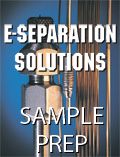Thermal Modulation in Multidimensional GC
Why is thermal modulation more widely discussed than flow modulation in comprehensive multidimensional gas chromatography?
The following question and answer were taken from the July 1, 2009, installment of LCGC Europe’s “The Column” e-zine. The answer was supplied by Matthew Klee of Agilent Technologies.
Q: Why is thermal modulation more widely discussed than flow modulation in comprehensive multidimensional gas chromatography?
Matthew Klee: The original work by Phillips and coworkers (1) in comprehensive multidimensional gas chromatography in the early 1990s involved thermal modulation. This concept is straightforward and relatively easy to understand: effluent from the primary column is cyclically focused and then reinjected into a secondary column continuously throughout the run. This modulation of the first-dimension effluent repeats with cycle times in the order of seconds.
The literature is dominated by reference to thermal modulations simply because this was the initial focus. Over the years, the design of thermal modulations has progressed to the point where several fully functional versions are commercially available from several sources. Awareness of the technology and development of the technique has been championed by a tight group of researchers in industry and academia and a couple of instrument companies concentrating on this area. As is the case with most techniques, it is rare to find one approach that excels at everything. The same thing applies to thermal modulation. Effective thermal modulation requires that the trapping and the desorption steps both work well. Trapping of light sample components requires very cold temperatures. It is extremely difficult and expensive to do both well. So any given thermal modulator will have a “sweet spot” of sample component volatility where it works well. The sweet spot is dependent on the choice of columns, parameters such as temperature program and column flow, and modulator hardware design, stationary phase thickness, and cryogen or cooling gas used.
In addition, many thermal modulator users find the cost of and inconvenience of using large amounts of cryogen to be prohibitive for routine use. There are some options for cryogen-free cooling, but they require higher initial investment and may cover an even narrower range of solute volatility than their cryogenic counterparts.
(1) Z. Liu and J.B. Phillips, J. Chrom. Sci.29, 227 (1991).
Analysis of Pesticides in Foods Using GC–MS/MS: An Interview with José Fernando Huertas-Pérez
December 16th 2024In this LCGC International interview with José Fernando Huertas-Pérez who is a specialist in chemical contaminants analytics and mitigation at the Nestlé Institute for Food Safety and Analytical Sciences at Nestlé Research in Switzerland, In this interview we discuss his recent research work published in Food Chemistry on the subject of a method for quantifying multi-residue pesticides in food matrices using gas chromatography–tandem mass spectrometry (GC–MS/MS) (1).
The Use of SPME and GC×GC in Food Analysis: An Interview with Giorgia Purcaro
December 16th 2024LCGC International sat down with Giorgia Purcaro of the University of Liege to discuss the impact that solid-phase microextraction (SPME) and comprehensive multidimensional gas chromatography (GC×GC) is having on food analysis.





